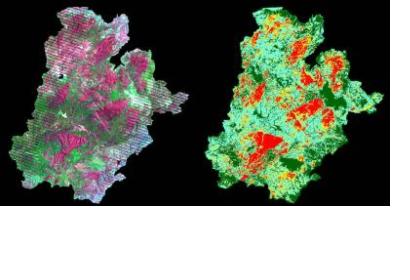NASA satellite images regularly map active fires around the world. Once a fire is out, satellite data and maps are also used by scientists to measure and protect the scorched land, and have played an important role in streamlining fire recovery efforts. The Remote Sensing Applications Center (RSAC), operated by the U.S. Department of Agriculture Forest Service, and other national agencies that specialize in fire recovery use Landsat 5 and 7 satellite data to observe vegetation, water and soil changes after a fire. These observations are then used by fire response teams to protect houses and other buildings near the fire site, in addition to wildlife and bodies of water.
This summer RSAC's data visualization team used Landsat satellite data to create a map of the Wallow North Fire in Arizona, depicting ecologic changes due to high temperatures. The Wallow fire raged from April to July, 2011 in southeastern Arizona. The Landsat Program is a series of Earth-observing satellite missions jointly managed by NASA and the U.S. Geological Survey (USGS). Since 1972, Landsat satellites have consistently collected critical information about Earth from space.
Landsat 5 and 7 satellites collect large amounts of image data while in orbit; each satellite orbits the Earth approximately 15 times per day and the orbits bring the entire Earth within view of the sensor on each satellite once every 16 days. Landsat quantifies visible, infrared, and thermal energy that is reflected or emitted from the Earth's surface. From these data specialists produce color-coded maps that depict and characterize vegetation, land use, and other landscape changes over time, including fires.
The satellite data can tell scientists and land managers how fire transforms the land surface as well as enable them to measure how this transformation alters the ecosystem. For example, intensely burned soils resist rainwater infiltration, leading to increased runoff, erosion, land slides and flooding. Land managers use satellite data to help indentify, locate and map burned areas most susceptible to increased runoff and erosion. Fire response teams then treat burned sites with a variety of measures to minimize erosion, such as spreading ryegrass seeds to stabilize the soil, and placing straw mulch on hill slopes for ground cover to intercept rainfall before it hits the burned soil.
The response depends on the intensity and behavior of a fire. Fires do not burn with uniform intensity across landscapes–rather they leave a mosaic of altered habitats. Though some burned areas will respond naturally with vigorous re-growth, others demand more immediate and intensive efforts. Satellite maps help recovery teams to pinpoint the places where their efforts are most needed, and to determine the type of response that would be most appropriate.
Near the end of a fire's life, a Burned Area Emergency Response (BAER) team, including geographic information systems (GIS) specialists, wildlife biologists and hydrologists, assesses the condition of the land. Within a week of this assessment the team creates a prescription plan used by local fire response teams to protect the public and residences. A critical part of this assessment includes mapping soil burn severity, which the BAER team does using Landsat-derived maps provided by the RSAC.
For more information, please click on the link to the original article.

